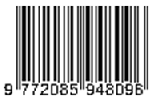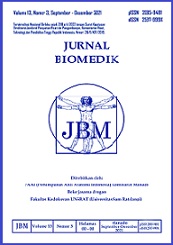POLA KUMAN AEROB PENYEBAB DIARE PADA ANAK BALITA DAN UJI KEPEKAAN ANTIBIOTIK DI BAGIAN ILMU KESEHATAN ANAK RSUP PROF. DR. R.D. KANDOU MANADO PERIODE MARET 2011-SEPTEMBER 2011
DOI:
https://doi.org/10.35790/jbm.4.3.2012.798Abstract
Abstract: Diarrhoea is an increase of defecation frequency greater than usual (more than three times daily), associated with changes of the form and consistency of stools, soft or fluidy, and with or without mucus or blood. The causative agents of diarrhoea are e.g. Campylobacter, Salmonella, Shigella, dan Escherichia coli. Microbes’ sensitivities against antibiotics can change from time to time, and from area to area. The purpose of this study was to find out the profile of aerobes that caused diarrhoea in childen under five admitted to the Children’s Department, at the Prof Dr.R.D. Kandou General Hospital, as well as the sensitivity and resistency tests of microbes against antibiotics. Feces samples of the children were cultured, and microbial identifications and sensitivity tests against antibiotics were done. The causative microbes were Escherichia coli (40%); and Klebsiella aerogenes, Klebsiella pneumonia, and Enterobacter aerogenes (each of them 3.3%). Sensitivity tests against meropenem were 96.7% and against amikacin 90.0%. Resistency tests to antibiotics showed sulpha methoxazole-trimethoprim 100%, cefazolin 100%, chloramphenicol 96.7%, doxycicline 83.3%, ampicillin 100%, and ceftriaxon 60%. Conclusion: the microbe that most caused diarrhoea in children under five admitted to the Children’s Department of the Prof dr.R.D. Kandou General Hospital was Escherichia coli, and the most sensitive antibiotics against this microbe were meropenem and amikacin.
Key words: microbes’ profile, diarrhoea, under five, sensitivity, antibiotics
Abstrak: Diare adalah frekuensi buang air besar yang bertambah dari biasanya (lebih dari tiga kali), ditandai dengan perubahan bentuk dan konsistensi tinja yang lembek sampai cair, dengan atau tanpa darah atau lendir dalam tinja. Penyebab diare antara lain: Campylobacter, Salmonella, Shigella, dan Escherichia coli. Kepekaan kuman terhadap antibiotik dapat berbeda dari waktu ke waktu dan dari daerah ke daerah. Tujuan penelitian ini untuk mendapatkan pola kuman aerob penyebab diare pada balita, serta kepekaan dan resistensi kuman terhadap antibiotik. Feses balita yang rawat inap di Bagian Ilmu Kesehatan Anak RSUP Prof. Dr. R.D Kandou Manado dengan diare dibuat kultur, identifikasi kuman, dan uji kepekaan terhadap antibiotik. Kuman penyebab diare yaitu Escherichia coli (40%), Klebsiella aerogenes, Klebsiella pneumonia, serta Enterobacter aerogenes (masing-masing 3,3%). Kepekaan kuman terhadap antibiotik meropenem 96,7% dan amikacin 90,0%. Resistensi antibiotik diperoleh terhadap sulpha methoxazole trimethoprim sebesar 100%, cefazolin 100%, chloramphenicol 96,7%, doxycicline 83,3%, ampicillin 100%, dan ceftriaxon 60%. Simpulan: kuman penyebab diare terbanyak pada anak balita yang dirawat inap di Bagian Anak RSUP Prof Dr. R.D. Kandou Manado ialah Escherichia coli dan kepekaan antibiotik yang terbaik ialah meropenem dan amikasin.
Kata kunci: pola kuman, diare, balita, kepekaan, antibiotik
Downloads
Issue
Section
License
Penyunting menerima sumbangan tulisan yang BELUM PERNAH diterbitkan dalam media lain. Naskah yang masuk dievaluasi dan disunting keseragaman format istilah dan cara penulisan sesuai dengan format penulisan yang terlampir dalam jurnal ini.
Segala isi dan permasalahan mengenai tulisan yang yang diterbitkan dalam jurnal menjadi tanggung jawab penuh dari penulis.







